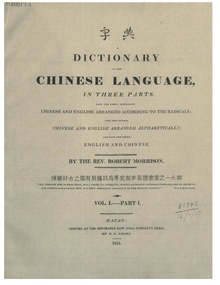A Dictionary of the Chinese Language

A Dictionary of the Chinese Language, Part I, Vol. I, title page (Morrison 1815a)
|
|
| Author | Robert Morrison |
|---|---|
| Country | Macau |
| Language | Chinese, English |
| Publisher | Peter Perring Thoms |
|
Publication date
|
1815-1823 |
| Media type | |
| Pages | 4,595 |
| OCLC | 500112156 |
A Dictionary of the Chinese Language, in Three Parts or Morrison's Chinese dictionary (1815-1823), compiled by the Anglo-Scottish missionary Robert Morrison was the first Chinese-English, English-Chinese dictionary. Part I is Chinese-English arranged by the 214 Kangxi radicals, Part II is Chinese-English arranged alphabetically, and Part III is English-Chinese also arranged alphabetically. This groundbreaking reference work is enormous, comprising 4,595 pages in 6 quarto volumes and including 47,035 head characters taken from the 1716 Kangxi Dictionary. However, Morrison's encyclopedic dictionary had flaws, notably failing to distinguish aspirated consonants: the pronunciation taou is given for both aspirated táo (, "peach") and unaspirated dào (, "way; the Tao").
Robert Morrison (1782-1834) is credited with several historical firsts in addition to the first bidirectional Chinese and English dictionary. He was the first Protestant missionary in China, started the first Chinese-language periodical in 1815 (Wilkinson 2015:850), collaborated with William Milne to write the first translation of the Bible into Chinese in 1823, helped to found the English-language The Canton Register in 1827, and compiled the first Western-language dictionary of a regional variety of Chinese (Morrison 1828).
Morrison joined the London Missionary Society in 1804 and was chosen to lead a mission to China. They sent him to study at Gosport and introduced him to a young Cantonese man studying English in London: Robert Morrison transcribes his name as "Yong Sam Tak", Eliza Morrison as "Yung-san-tih" in "Mandarin" transcription (Morrison 1839, Vol. I, p. 217.), and whose actual name was probably Rong Sande () (Strandenaes 2004:126–7). In 1807, the LMS instructed Morrison to sail to Guangzhou (then known as "Canton") and continue studying until he had "accomplished [his] great object of acquiring the language", whereupon he would "turn this attainment into a direction which may be of extensive use to the world: perhaps you may have the honour of forming a Chinese Dictionary, more comprehensive and correct than any preceding one", as well as translating the Bible into Chinese (Morrison 1839, Vol. I, p. 70).
...
Wikipedia
